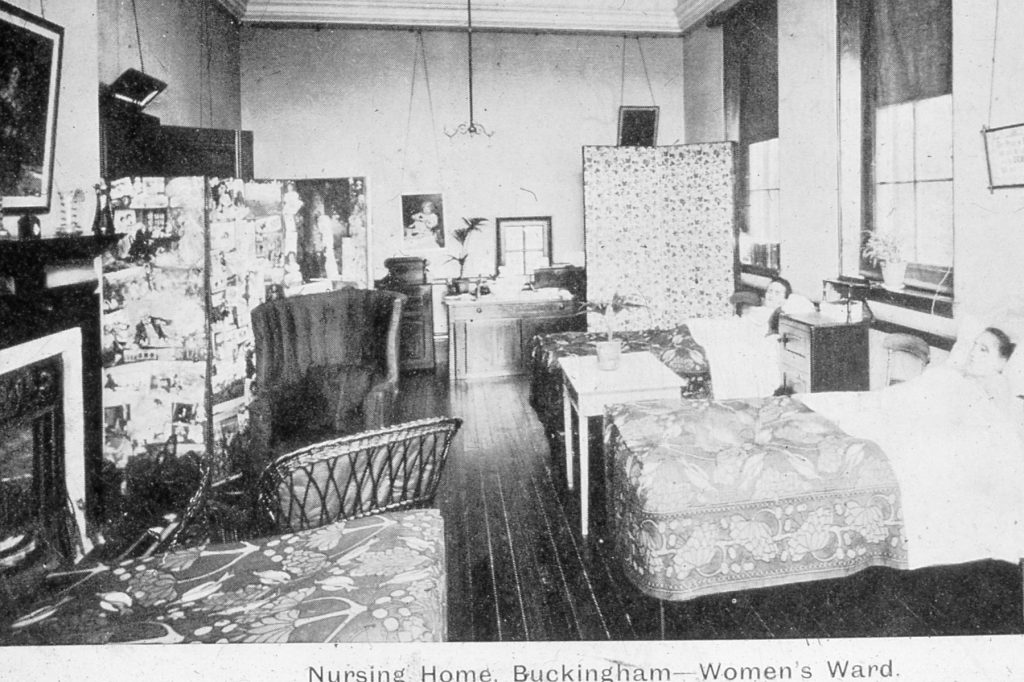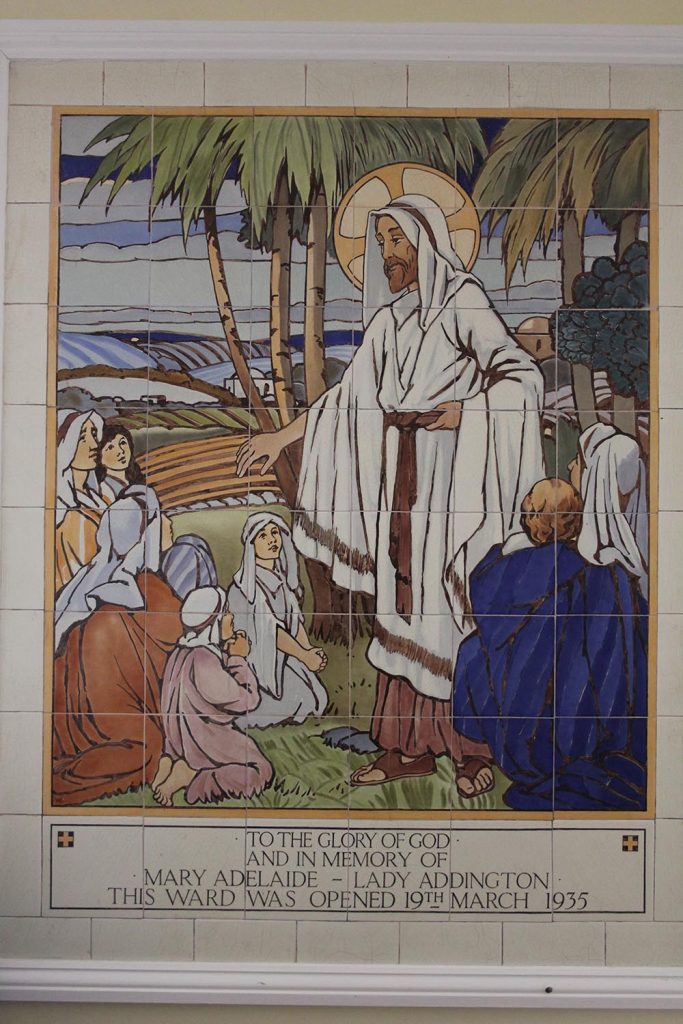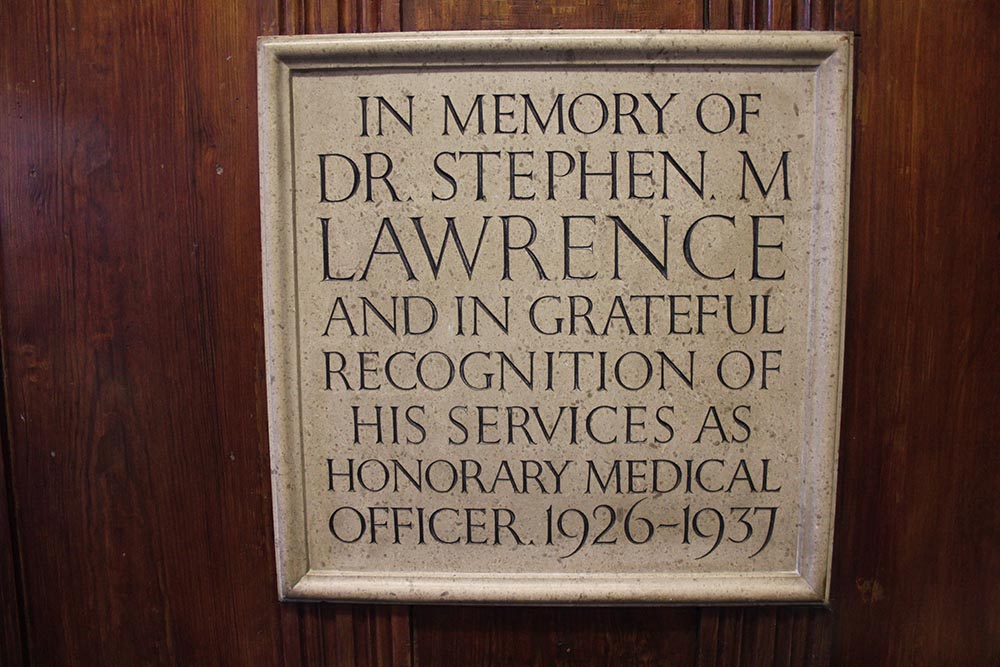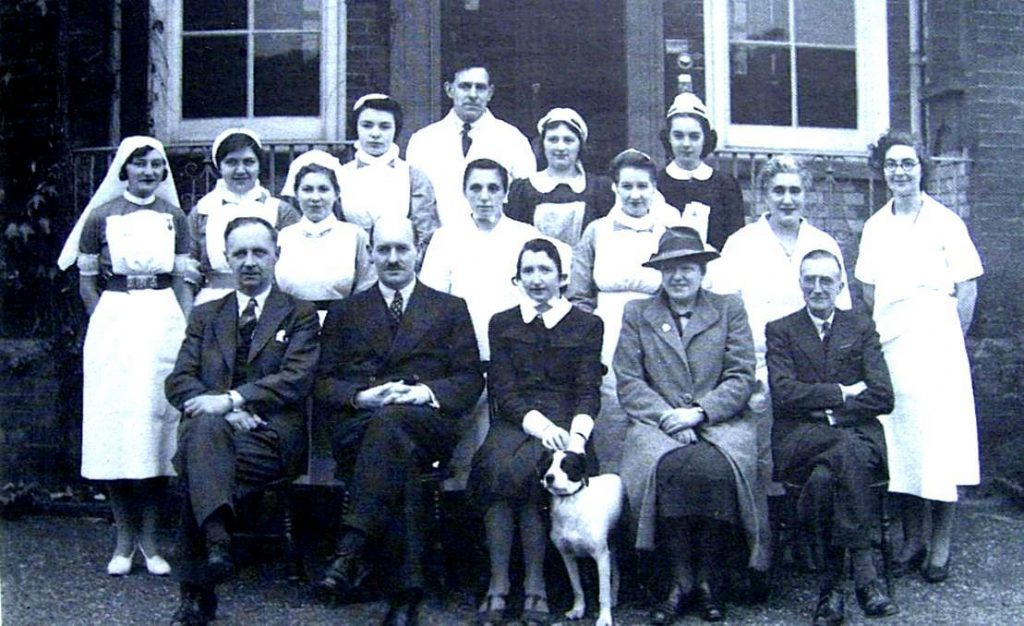Buckingham Hospital
A Hundred and Fifty Years Serving the Community
From the middle ages onwards, a sense of responsibility for the care of the sick and poor in society was felt by both lay and professional people and it was commonplace for the laity and the clergy to establish hospitals which were ecclesiastical rather than medical and which provided care rather than cure.
This was the principle which led to the founding of the Buckingham Nursing Home, the forerunner of Buckingham Community Hospital, in 1870. It was through the efforts of one man, Canon William Foxley Norris (1825-1906), the then vicar of Buckingham, that the Nursing Home was established at 5 Castle Street, Buckingham. He founded the Home in conjunction with the Buckingham Parish Church and parish registers of the time reveal his own handwritten notes:
‘1870 – Nursing Home and Hospital formed as an additional part of Church work in Castle Street – a Parishioner gave the House rent free for her lifetime i.e. lent to me during my incumbency.’
The Home was supported by voluntary contributions and was described as ‘a Nursing Home and small hospital where trained nurses from London reside, receive a few patients and nurse in the towns and villages of the neighbourhood’. This was the first mention of an embryo district nursing service where the same nurses visited patients in their own homes as well as carrying out their hospital work.
In January 1875, the then Conservative MP for the Borough of Buckingham, Egerton Hubbard, was riding from the family home at Addington near Winslow to attend a public meeting in Buckingham. His horse stumbled and Egerton was thrown off, sustaining a severe head injury. Against all expectations, he eventually recovered and news of the accident and his recovery attracted a great deal of sympathy locally and in the surrounding area.

John Gellibrand Hubbard, Egerton’s father and the first Lord Addington, together with his wife, Lady Addington, were overwhelmed by the depth and extent of public feeling and concern for their son and they pledged to show their gratitude in some tangible way. An opportunity arose some years later when the country celebrated the Golden Jubilee of Queen Victoria in 1887. Having purchased four acres of land at North End, Buckingham, J.G. Hubbard erected the new Nursing Home – the present Buckingham Community Hospital – at a cost of approximately £4,500 and presented the building and land to the Borough of Buckingham.

Rural district nursing had continued to develop since the founding of the old Home in 1870 and there was a Rural District Nursing Association with its own subscribers. In 1897 this was amalgamated with the Nursing Home to form the Buckingham Nursing Home and Rural District Nurses Association with Egerton Hubbard, now the second Lord Addington, as president.

The Home was opened on 25 March 1887 and was funded by a combination of voluntary contributions, gifts and legacies, and a complicated system of subscriptions. Payment of a subscription of an appropriate amount, anywhere between £2 and £40 per annum in 1887, entitled the subscriber to a so-called ‘letter of recommendation’ which had to be signed by a medical man and with which a patient could be admitted to the Home free of charge for a specified length of time; for example, a subscription of two guineas (£2.10 in today’s money) entitled a patient to a stay of three weeks.
A young general practitioner in Buckingham at the time, Dr George De’Ath, encouraged the rural district nursing in association with the Home and in 1892 supported Florence Nightingale’s efforts to establish ‘rural health missioners’, the forerunners of today’s health visitors. Florence Nightingale had strong connections to the area, her sister Frances Parthenope Verney being married to Sir Harry Verney of Claydon House, where Florence was a frequent visitor. Dr De’Ath, probably the most remarkable and most respected of Buckingham’s late Victorian medical practitioners, died in 1901 from heart failure exacerbated by overwork, at the relatively young age of 39 years.
The 20th Century
So the Home entered the twentieth century with the institution running at a financial deficit. Various suggestions for improvements were put forward such as a children’s ward, a room for small operations – at the time surgical operations were performed on the wards – and the installation of electric light. The biggest effect of the Great War (1914-18) was that nursing staff became difficult to find, the majority working in France on the Western Front, and the problem became so acute that by 1916 even closure of the Home was considered.
Financial difficulties continued after the War and a scheme for a new operating theatre, a children’s ward, two additional nurses’ bedrooms, improved staff and patient lavatories and bathrooms, and a new staircase had to be postponed because of the lack of funds despite the launch of a Victory Appeal for the so-called ‘Victory Wing’. Eventually, limited work was carried out that saw the installation of electric light and central heating, the building of two nurses’ bedrooms and a staff bathroom, and alterations to the main staircase.

In 1921, the Home was renamed the ‘Cottage Hospital’ and in 1930 the long awaited operating theatre was opened. The death of Egerton Hubbard’s widow, the second Lady Addington, in 1933, led to the setting up of a fund in her name and in 1935, the New Wing was opened with a four-bedded children’s ward on the first floor – the Lady Addington Memorial Ward – and new nurses’ quarters on the ground floor.

As in 1914, when world war came in September 1939, the Hospital was again in financial difficulties. Moves to amalgamate with the Oxford and District Joint Hospitals Board were considered, more so as it was heard that the philanthropist Lord Nuffield had given £300,000 to the Board. Unfortunately, no definite arrangements could be made and the Hospital struggled on financially until the coming of the NHS in 1948.
Dr John Bostock who was to become another highly respected local GP had started work in the town in 1927 and he was appointed medical officer in charge of the Hospital for the wartime emergency measures, as well as serving in the local Home Guard. When the NHS was launched on 5 July 1948, the Hospital’s so-called voluntary status was brought to an end after 61 years. After being run by a management committee for all that time, the transfer of the Hospital to public ownership saw it come under the authority of the Aylesbury and District Hospital Management Committee, part of the Oxford Regional Hospital Board.

The early years of the NHS were characterised by severe staff shortages, but a number of minor improvements were made – such as the conversion of two outbuildings at the staff cottage in the grounds to form a physiotherapy department in 1962 and a year later the upgrading of the outpatient department.
The Hospital reached its nadir in 1967 when, in response to another threat of closure, the League of Friends was formed. The Hospital had a stay of execution and the League gradually increased its fundraising activities. An NHS reorganisation in 1974 saw the Hospital come under the control of the Aylesbury and Milton Keynes District Health Authority, part of the Oxford Regional Health Authority.
In 1977, a scheme devised by another of the town’s GPs, Dr Christopher Brown, saw local industry pledge £10,000 per annum for five years in return for expansion of the outpatient facilities, with the employment of a clinic nurse and a clerk, the installation of an X-ray unit and lift, and the provision of a radiographer to staff the X-ray unit. The advantage of these arrangements was that employees would be seen locally rather than having to attend major units in Aylesbury or Oxford which would often mean the loss of a whole day from work.

The new outpatient services started in September 1977, patients were seen in the X-ray unit in February 1979, and the new lift was installed and working by February 1981. Following these improvements, plans were then laid for a major extension to the rear of the original building to provide a 22 bedded unit, with the existing wards being used for other purposes. This project was finished and in use by early 1989, with the League of Friends contributing £174,000 towards the one million pound project. On 22 May 1991, HRH The Duke of Kent officially opened the new extension.
On 25 May 1987, the League of Friends was to the fore in celebrations to commemorate the hundredth anniversary of the opening of the Hospital and J.G. Hubbard would have been proud, if also a little surprised, that his name was still being spoken with such reverence one hundred years after he had proudly declared that he hoped ‘the building would be used for the purpose for which it had been erected for time immemorial’.
Towards the turn of the century and into the new millennium, the NHS became even more politicised when successive governments introduced seemingly endless reforms as they struggled to finance a service that had to deal with more and more demand, due in large part to an ageing population and costly advances in medical technology.
In 1990, the National Health Service and Community Care Act (in England) was passed and introduced the concept of an ‘internal market’. Health Authorities ‘purchased’ healthcare from their own and other authorities’ hospitals as well as other health organisations. GPs became so-called ‘fund holders’ and purchased care for their own patients, thereby introducing the concept of ‘providers’. This led to the setting up of NHS trusts which encouraged competition but also introduced local and regional differences in what was, after all, a ‘national service’. As a result of these changes, Buckingham Hospital became part of the Aylesbury Vale Community Healthcare NHS Trust on 1 April 1992.
The 21st Century
The new Labour administration that came to power in 1997 aimed to remove the internal market and abolish fund holding, and the NHS which celebrated its fiftieth anniversary in 1998, became increasingly focused on ‘integrated care’ and services in the community. The first decade of the new millennium saw yet further organisational change with the creation of Primary Care Trusts (PCTs) in 2002. These provided primary care services and commissioned secondary care services from providers, and Buckingham Hospital came under the auspices of Buckinghamshire Hospitals NHS Trust a year later.
In October 2006, Strategic Health Authorities (SHAs) were created with the responsibility of coordinating the strategies of trusts in their regions, and in 2010 the community and acute hospital services in the county were brought together under one organisation, the Buckinghamshire Healthcare NHS Trust. However, at Buckingham Hospital the number of beds open at any one time fluctuated according to the nursing complement available and to whatever policy was in force at any particular time with regard to nurse recruitment.
The Conservative-Liberal Democrat coalition government of 2010 passed the Health and Social Care Act in 2012 which abolished SHAs and PCTs, devolving responsibility for the control of 80% of the NHS budget to GPs through Clinical Commissioning Groups (CCGs). The aim was to facilitate patient choice and cut administrative costs, but the Act only seemed to presage an unparalleled period of under-investment, culminating in 2020 in unprecedented pressure on the NHS and social care systems as a result of a worldwide pandemic caused by the SARS-CoV-2 virus (Covid-19).
During this time, the League of Friends has continued its work of supporting the Hospital, staff and patients. Investment income, standing orders, house-to-house collections and bequests by grateful patients and their relatives has guaranteed a steady income to finance these aims. In 2010, the League paid for the services of a locum physiotherapist which resulted in a reduced waiting time for physiotherapy from sixteen weeks to four weeks over a few months. The installation of a new X-ray machine in March 2014, which made available the first digital X-ray equipment in the Buckinghamshire Healthcare Trust, was part funded by the League, with a donation of £70,000.
A new threat to the Hospital surfaced in 2017 when the Trust launched its community hubs programme at two pilot sites in Marlow and Thame. In-patient beds at the two community hospitals in the towns were closed and were replaced by a community assessment and treatment service which aims to help frail, older patients avoid an accident and emergency attendance or a hospital admission. At the same time in Buckingham, plans were being made for a new state-of-the-art health hub – the Buckingham Healthcare Centre – at the Lace Hill development, but uncertainty remains about what effect a community hub in Buckingham would have on Buckingham Hospital, the building itself, its outpatient services and the in-patient beds.